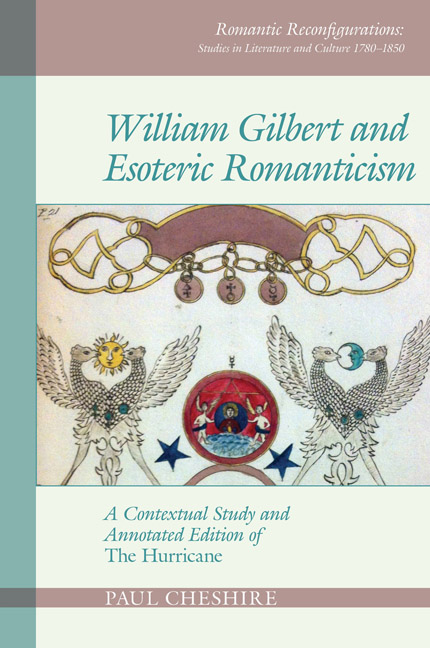 William Gilbert and Esoteric Romanticism
William Gilbert and Esoteric Romanticism from Part One - William Gilbert in Romantic Culture
MR. WILLIAM GILBERT will teach Astrology and Spirit, with the nature and use of Talismans, on the following scheme:
First Class of Pupils.—One hundred and fifty pounds per annum; or, one hundred guineas down.
The lowest.—Twenty pounds per annum; or, fifteen guineas down.
(CM, I: p. 400)1788–89 Henderson's Asylum
William Gilbert's first appearance in Bristol took place six years before Coleridge was to burst in, tanned, shaggy-haired and travel-stained, after a walking tour of Wales, to meet up with Robert Southey and inaugurate Bristol's Romantic era. In 1788, Coleridge's future publisher, Joseph Cottle, barely eighteen years old, was at home with his elder brother, when John Henderson, their ex-schoolteacher, called in accompanied by Gilbert, whom he introduced as ‘the Young Counsellor’. Henderson and Gilbert had walked the four miles into the city from a run-down Elizabethan grange, then being used as a mental asylum, outside the village of Hanham. John Henderson was the son of the asylum's owner, and Gilbert was a patient in his charge. Cottle recalled this meeting in his memoirs written some fifty years later:
I spent an afternoon with them, not readily to be forgotten. Many and great talkers have I known, but Wm. Gilbert, at this time, exceeded them all. His brain seemed to be in a state of boiling effervescence, and his tongue, with inconceivable rapidity, passed from subject to subject, but with an incoherence that was to me, at least, marvellous. For two hours he poured forth a verbal torrent, which was only suspended by sheer physical exhaustion.
(CER, II: p. 314)Gilbert's confinement in the asylum had begun towards the end of that summer of 1788.
He had become unbalanced after losing a legal case in Portsmouth, which, according to Cottle, was to be a first step towards establishing himself professionally in England as a counsellor at law (a legal role falling short of barrister).
While at his lodgings, he interpreted the words of Christ personally, ‘Sell all thou hast and distribute to the poor’ […], and, therefore, one morning he tumbled everything he had in his room, through the window, into the street, that the poor might help themselves; bed, bolsters, blankets, sheets, chairs.[…] Two or three other extravagances convinced his friends that confinement was indispensable, and they placed him in Mr. Richard Henderson's Asylum, at Hanham, near Bristol.
(CER, II: pp. 325, 314)To save this book to your Kindle, first ensure [email protected] is added to your Approved Personal Document E-mail List under your Personal Document Settings on the Manage Your Content and Devices page of your Amazon account. Then enter the ‘name’ part of your Kindle email address below. Find out more about saving to your Kindle.
Note you can select to save to either the @free.kindle.com or @kindle.com variations. ‘@free.kindle.com’ emails are free but can only be saved to your device when it is connected to wi-fi. ‘@kindle.com’ emails can be delivered even when you are not connected to wi-fi, but note that service fees apply.
Find out more about the Kindle Personal Document Service.
To save content items to your account, please confirm that you agree to abide by our usage policies. If this is the first time you use this feature, you will be asked to authorise Cambridge Core to connect with your account. Find out more about saving content to Dropbox.
To save content items to your account, please confirm that you agree to abide by our usage policies. If this is the first time you use this feature, you will be asked to authorise Cambridge Core to connect with your account. Find out more about saving content to Google Drive.